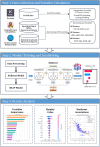What factors influence the willingness and intensity of regular mobile physical activity?- A machine learning analysis based on a sample of 290 cities in China
- PMID: 39916701
- PMCID: PMC11798996
- DOI: 10.3389/fpubh.2025.1511129
What factors influence the willingness and intensity of regular mobile physical activity?- A machine learning analysis based on a sample of 290 cities in China
Abstract
Introduction: This study, based on Volunteered Geographic Information (VGI) and multi-source data, aims to construct an interpretable macro-scale analytical framework to explore the factors influencing urban physical activities. Using 290 prefecture-level cities in China as samples, it investigates the impact of socioeconomic, geographical, and built environment factors on both overall physical activity levels and specific types of mobile physical activities.
Methods: Machine learning methods were employed to analyze the data systematically. Socioeconomic, geographical, and built environment indicators were used as explanatory variables to examine their influence on activity willingness and activity intensity across different types of physical activities (e.g., running, walking, cycling). Interaction effects and non-linear patterns were also assessed.
Results: The study identified three key findings: (1) A significant difference exists between the influencing factors of activity willingness and activity intensity. Socioeconomic factors primarily drive activity willingness, whereas geographical and built environment factors have a stronger influence on activity intensity. (2) The effects of influencing factors vary significantly by activity type. Low-threshold activities (e.g., walking) tend to amplify both promotional and inhibitory effects of the factors. (3) Some influencing factors display typical non-linear effects, consistent with findings from micro-scale studies.
Discussion: The findings provide comprehensive theoretical support for understanding and optimizing physical activity among urban residents. Based on these results, the study proposes guideline-based macro-level intervention strategies aimed at improving urban physical activity through effective public resource allocation. These strategies can assist policymakers in developing more scientific and targeted approaches to promote physical activity.
Keywords: built environmental factors; geographical environmental factors; machine learning; mechanisms of influence; physical activity; socioeconomic factors; willingness and intensity.
Copyright © 2025 Shen, Shu, Zhang, Liu and Li.
Conflict of interest statement
The authors declare that the research was conducted in the absence of any commercial or financial relationships that could be construed as a potential conflict of interest.
Figures










References
-
- Strain T, Flaxman S, Guthold R, Semenova E, Cowan M, Riley LM, et al. . National, regional, and global trends in insufficient physical activity among adults from 2000 to 2022: a pooled analysis of 507 population-based surveys with 5·7 million participants. Lancet Glob Health. (2024) 12:e1232–43. doi: 10.1016/S2214-109X(24)00150-5, PMID: - DOI - PMC - PubMed
MeSH terms
LinkOut - more resources
Full Text Sources
Medical

